Hypothyroidism treatment depends on personal case. It is caused due to low thyroid hormones in the bloodstream. This happens because the thyroid glands do not produce sufficient thyroid hormones. It is slowing the metabolism and can lead to various symptoms.
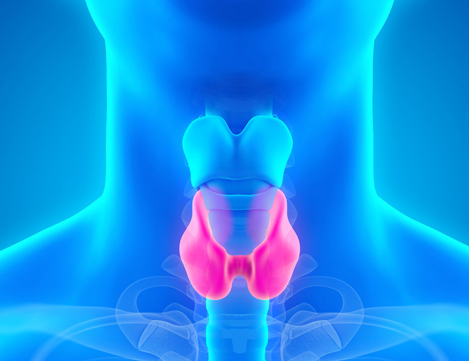

Symptoms of Hypothyroidism
Symptoms depend on of deficiency severity of thyroid hormones and vary according to a person. Hypothyroidism develop slowly over many years of time.
At the beginning key symptoms of low thyroid functions such as weight gain, fatigue … can be experienced.
After some time, gradually the metabolism starts to get low, and the other symptoms can be developed with time.
- Fatigue
- Weight gain
- Increased sensitivity to cold
- Dry skin
- Puffy face
- Weakness in the muscles, muscle ache, tenderness and stiffness
- Pain, stiffness or swelling in the joints
- Constipation
- Hoarseness of voice
- Thinning of hairs
- Slow heart rate
- Elevated levels of blood cholesterol
- Enlarged thyroid glands (goiter)
- Irregular or heavy menstrual periods
- Depression
- Impaired memory
Who are prone to develop hypothyroidism
- Woman
- During pregnancy or 6 month after delivery
- After 60 years
- Family history of thyroid disease
- Suffering from an autoimmune disease such as celiac disease or type 1 diabetes mellitus
- Undergone thyroid surgery
Home Remedies, lifestyle changes
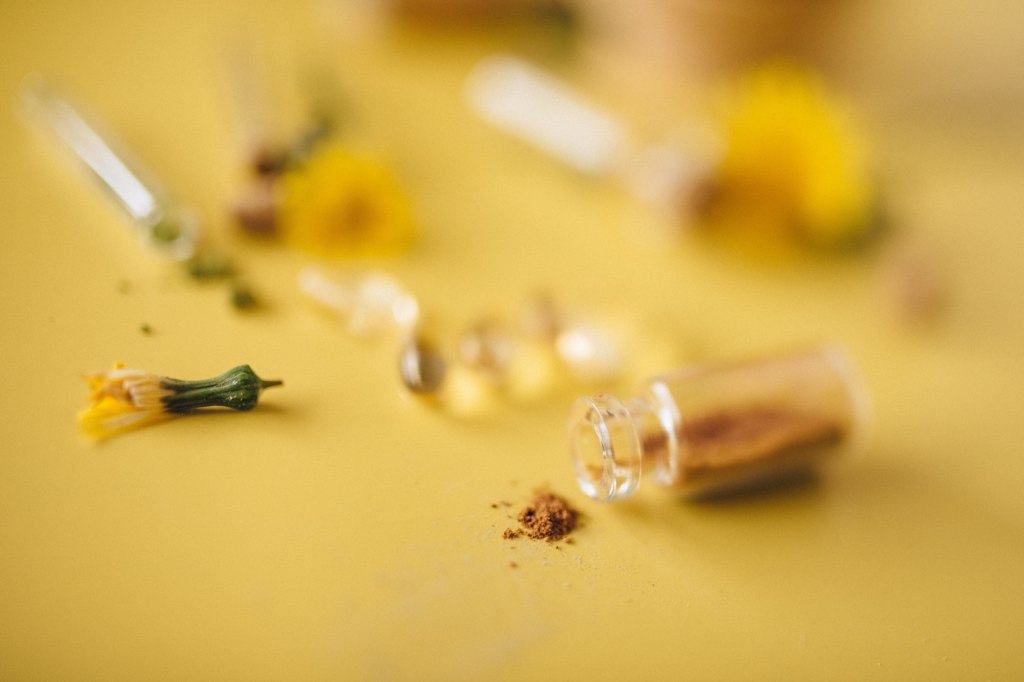

For sure, home remedies are good to maintien and can help the treatment of hypothyroidism but are not enough.
All the home remedies and lifestyle indicated below will help to improve and balance thyroid functions but other rasayana are necessary to treat hypothyroidism.
Diet and Hypothyroidism
Diet :
- Low in fat
- A good balance of fruits, vegetables, dairy, whole grains and lean protein.
- Reduce the amount of carbohydrate in your diet but completely avoiding carbohydrate is not recommended.
- Reduce the amount of salt intake, ideally less than 2/3 grams per day. Rock salt is a better replacement to table salt, because it is rich in minerals.
Balanced and wholesome diet
Choose food fresh and not preserved, processed or canned.
Eat warm and freshly homemade meals with natural ingredients as much as you can.
Don’t use hydrogenated oils, vegetable oils, artificial colors and flavors or white flour. Instead use sesame oil for cooking, it helps to burn fat and nourishing deeply the tissues
Coconut oil is also good if you leave in a hot climate because coconut is coolant
Eat vegetables, fruits and whole grains.
They reduce effects of hypothyroidism and boost up immunity.
No soy products and soybeans.
They aggravate hypothyroidism symptoms because they contain goitrogenic compounds that interfere with levels of thyroid hormone.
Use essential oils and fatty acids like fish oils which are good sources of omega 3.
They promote production of thyroid hormones, immunity enhancers and also anti-inflammatory.
Use natural fats
They help maintaining hormonal balance : flaxseeds, walnuts, avocado, fish.
Avoid caffeine, sugar and starchy foods.
Starchy foods reduce metabolism and increase adverse effects of hypothyroidism.
Increase protein in your meal.
Proteins reduce production of thyroid hormones by regulating the thyroid functions. For that nuts, green vegetables, legumes, eggs and meat are rich in protein and help in combating hypothyroidism symptoms.
Consume food with selenium: eggs, legumes, tuna, turkey. Because selenium in the body is reduced in Hashimoto’s thyroiditis. Selenium supplements shows it role to balance thyroxine (T4) levels.
Forget sugar and processed foods. As already mentioned in many of my articles, it increase inflammation in the body and slows down the conversion of T4 into T3. Then it is wise to have a sugar free diet.
Avoid gluten because many people with thyroid disease also have celiac disease. In celiac disease gluten triggers an immune response in the small intestines. Once wheat and other gluten rich foods are removed from the diet, people with hypothyroidism and Hashimoto’s thyroiditis start feeling better.
Gluten free grains and seeds – rice, flax seeds, chia seeds, buckwheat etc
Also, a low activity of thyroid can be due to low iodine in your diet. Have more of seafood, seaweeds, egg, shrimp, cheese and don’t use artificial iodine, always choose natural salt.
You can also include probiotics.
They can improve metabolism and the digestion. A bad digestion and low levels of good bacterias can reduce thyroid hormone production. Have more of buttermilk, yogurt, fermented vegetable pickles, kefir, saurekraut, miso.
An altered gastrointestinal motility is commonly seen with hypothyroidism and can cause diarrhea. Probiotics can bring helpful bacteria to balance the microbiote.
Use apple cider vinegar useful to reduce body weight, improve fat and carbohydrate metabolism and to balance alkaline-acid balance in the body. Apple cider also balance cholesterol, blood sugar and blood pressure. You can take 1 teaspoonful of apple cider vinegar and honey mixed in warm water will help in improving thyroid activity and control symptoms of hypothyroidism when consumed.
Regular exercise
Through a 30-minute exercise few thyroid-related symptoms like fatigue, loss of appetite and osteoporosis can be fought.
A level of high estrogen can cause hypothyroidism in women. Birth control pills, dairy products and consumption of large amount of meat may imbalance estrogen levels and deplete thyroid hormone production. These foods shall be avoided to maintain balance of thyroid hormones in the body.
Low thyroid hormones can affect absorption of vitamin B especially B-12 and B1 levels.
Vitamin B12 is helpful to prevent the tiredness related to thyroid disease.
To increase these vitamins you can add regularly in your diet : peas, beans, sesame seeds, cheese, eggs, asparagus.
Zinc regulate TSH as per some studies. Hypothyroidism patients should consume zinc rich foods: beans, nuts, crab, lobster, whole grains, breakfast cereals, and dairy products, avocados, blackberries, pomegranates, raspberries, guavas, cantaloupes, apricots, peaches, kiwifruit, and blueberries.
Diet is one of the most important thing but it will not cure hypothyroidism.
A combination of right nutrients and medication can help to restore thyroid function and minimize your symptoms.
Foods to avoid


We call that food goitrogens because it can interfere with normal function of thyroid gland.
I will give you some common examples.
Avoid regularly:
- vegetables like cabbage, broccoli, cauliflower, kale, spinach.
- Fruits and starchy plants like sweet potatoes, manioc, strawberries, peaches …
- Nuts and seeds: millet, pine nuts, peanuts etc
- Soy foods, tofu, tempeh etc
- offee, green tea, alcohol
Foods that contain goitrogens have to be eaten with moderation and ideally cooked because they are rich in calories and with hypothyroidism you may easily gain weight.
Also, too much fiber can interfere with absorption of thyroid medicine.
25 grams and 38 grams respectively are the recommended doses of fiber for women and men respectively. But don’t stop entirely their consumption, it is found in healthy foods like fruits, vegetables, beans and whole grain breads and cereals.
Iron and calcium. Foods containing iron and calcium are safe to eat but using them with food not in supplement because these minerals interfere with absorption of thyroid hormone medicine. Talk with your doctor if it is the case.
Hypothyroidism, gain weight and depression
The lack of Vitamin B 12 and Vitamin D is found in cases of autoimmune hypothyroidism.
Missing Vitamin D is directly linked with depression. Because of lake of sun exposure and long winters. Levels has to be checked.
Obesity management
Metabolism is slow in hypothyroidism and lead to gain weight. Keep a track on you weight and keep balance.
You can use of Triphala Churna, and other gulgulu based medication that can be useful to address obesity and also help with depression indirectly.
Exercising every day is also indicated. No need to do long work out, 20 to 30 minutes of effcicient exercizes are enough.
Who suffer from hypothyroidism sleep less and so can increase stress, anxiety and depression. Herbs are very useful and can be prescribed like Ashwagandha, Sarpagandha, Brahmi, Tagara etc.
Plan your meal and eat with mindfulness, how fast you eat, where you eat…
Try to sleep for at least 7-8 hours every night. When you sleep less you are likely to gain fat, mainly around the belly
Practice Yoga and Meditation. Research works show that Yoga and meditation are helpful in maintaining healthy weight. Therefore, they need to be practiced regularly to be efficient and with expericend yoga teacher to show you how to practice efficiently.
This is only an approach above. There are many ways to handle hypothyroidism, depends on your life history, the symptoms you feel, the level of your thyroid hormones… That is why it is important to check with your doctor all these recommendations which cannot be perfect for your condition but for another one.
Important Yoga postures for Hypothyroidism
Below mentioned are some of the most beneficial yoga postures for those suffering from hypothyroidism
Sarvangasana (Shoulder Stand)


This inversion helps balance the entire body and mind, from circulatory, respiratory system to endocrine and nervous system. It stimulates thyroid glands, boost immune system and helps calm the mind and relieves emotional and mental stress.
Begin by lying flat on your back. Relax your body. You can place a blanket under the shoulders for cushioning. Slowly begin to raise the legs off the mat, followed by buttocks and spine. Bend the elbows and place the hands behind the rib cage to support your spine.
In the final position, the legs are vertical and together and the arms continue to provide stability.
Viparita Karani Asana (Inverted Pose)
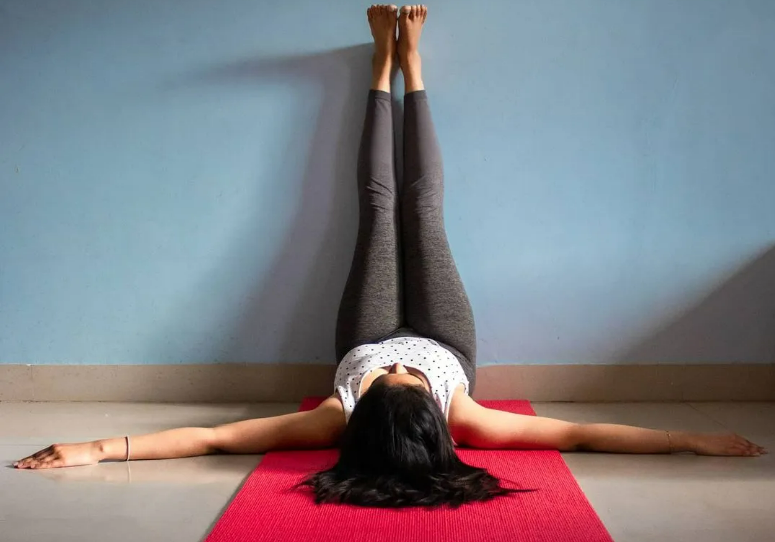

This asana has similar benefits as Sarvangasana as it increases blood flow to the neck region and helps in regulating thyroid glands and balance functions of other endocrine glands. All inversions help release gravitational weight from all organs. This asana helps ease complications caused by hypoactive thyroid.
Begin by lying flat on your back. Raise your legs up till they are perpendicular to the floor. Now gently lift your hips and place your palms under your lower back (waist level). With the support of your palms, and elbows pressed to the floor- working as prop, keep lifting your torso till it is around 45 degrees to the floor.
In the final position, the legs are at 90 degrees to the floor and the body is maintained at a 45 degree angle. Alternatively, you can use a yoga block to support your lower back.
Janu Sirsasana (Seated Head to Knee Pose)




This forward bend helps calm the nervous system, reduce stress and anxiety as it helps increase flexibility in hip joints and give a deep stretch to hamstring muscles. It is also helpful for those suffering from insomnia.
Sit with legs extended and feet together. Bend the left leg and place sole of the foot against right inner thigh. The closer the left heel to the perineum the better. Inhale and place hands on the right knee. Exhale and slowly begin to bend forward, sliding the hands down the right leg. If possible, grab your right foot or toes.
Stay in the forward bend for a few exhalations. Repeat with the right leg bent and left leg straight.
Matsyasana (Fish Pose)
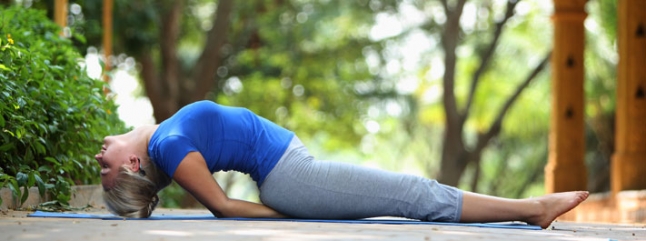

It is usually performed as a counter pose to inversions like Sarvangasana, Halasana or Viparita Karani asana as it provides a reverse stretch to the neck.This pose not only exposes the throat area and stimulates the thorax, but also stimulates the spine, cervical muscles and expands rib cage and lung capacity.
To begin, lie in supine with your hands resting next to the body. If you can, fold your legs in Padmasana, if not keep your legs straight on the floor. Bend your hands and with the help of your forearms on the floor, lift your back, chest, neck and head off the mat. Bring the top of your head / crown to rest on the mat, giving your neck a deep stretch. If holding padmasana, wrap your fingers around the big toe and try and rest your elbow on the mat, next to your body.
Stay in this posture for a few deep breaths. You can also attempt this pose from a seated Padmasana position and let the elbows support you as you gently drop your head back to rest the crown on the mat. You can use a headstand pillow as a prop for cushioning.
Do not do if any neck pain or back pain. Use can use props and put them on the floor to maintain your head straight and behind your back to maintain the posture, avoid any over strains and injuries in the body. Best is to practice with a yoga teacher.
Halasana (Plough Pose)




You may find it easier to hold a Halasana when compared to Sarvangasana. It helps improve function of thyroid, parathyroid, adrenal and pituitary glands, thus improving overall function of endocrine system. It helps reduce menopause symptoms, stimulates reproductive organs and is therapeutic for insomnia, infertility, backache and headache.
From Sarvangasana, drop your legs back, behind the head. Allow the toes to touch the floor and slowly straighten your knees to increase the distance between the head and toes. This will help you achieve a chin lock or Jalandhara bandha which is highly beneficial for thyroid function. The hands can continue to support the back. If comfortable, you can extend the hands, place them on the floor and interlace your fingers.
In the final pose the body resembles the plough. Thus the name Halasana. Stay in the pose for few breaths and return to Sarvangasana before releasing the posture completely and rest in supine.
Marjariasana (Cat-Cow Stretch)
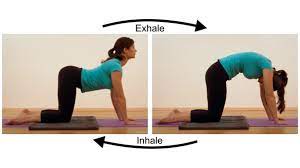

This vinyasa like flow for the back and neck helps release stress and improves body coordination. It is a combination of two asanas, Marjariasana (cat stretch) and Bitilasana (cow stretch) done with breath awareness to increase emotional balance. This pose helps stimulate abdominal region and organs like kidney and adrenal glands. It involves neck movement, which also works on the throat chakra.
Begin in table pose by placing your palms and knees on the floor. You can either place your insteps (flat) on the mat for stability through the practice or shift to balance on toes in cow stretch. First maintain a neutral spine and look straight. With the next inhalation, arch your back, allowing your belly button to sink closer to the floor and stretch your neck/head upward. As you exhale, drop your head and bring your chin closer to the chest as you simultaneously lift and round your spine outward and draw your navel towards your spine.
Repeat this fluid movement with breath awareness without using force to stretch the neck or forcing your chin to the chest. Keep your head and shoulders relaxed and let the movement be as natural as possible.
Surya Namaskar or Sun Salutation (fast-paced)
It is a popular sequence of yoga asanas done with breath awareness. It is a complete sadhna or yoga practice in itself and includes asana, pranayama, mantra and meditation techniques. 1 set comprises of 12 asanas. 1 cycle of sun salutation comprises of 2 such sets done for the right and left side.
Repeating these cycles help you lead an active and healthy life as it regulates and balances the solar energy of the body which flows through pingala nadi. It is performed in a steady rhythmic way which also reflects the biorhythms of the body, 24 hours of the day, and the 12 zodiac signs and this rhythmic process helps transform your mind and body completely.
You will experience a boost in immune system, improved digestion, increase in your lung capacity, and a balanced metabolism, reproductive and circulatory system. Regular practice helps in naturally balancing endocrine system and restoring hormonal balance, giving you a glowing skin, healthy bones, and a great mood to kick-start your day with positive energy.
Pranayama and Hypothyroidism
Apart from yoga asana, the practice of dynamic breathing exercises like Kapalbhati, Ujjayi Pranayama, Bhastrika and Nadi Shodhana Pranayama will help restore balance and regulate thyroid glands.
Ayurveda Understanding
No disease explained in Ayurveda can be directly correlated with hypothyroidism.
Hypothyroidism should be understood on the basis of vitiation of doshas, tissues and channels involved in pathogenesis of the disease and also its predominant symptoms as understood from Ayurveda perspective.
Agnimandya
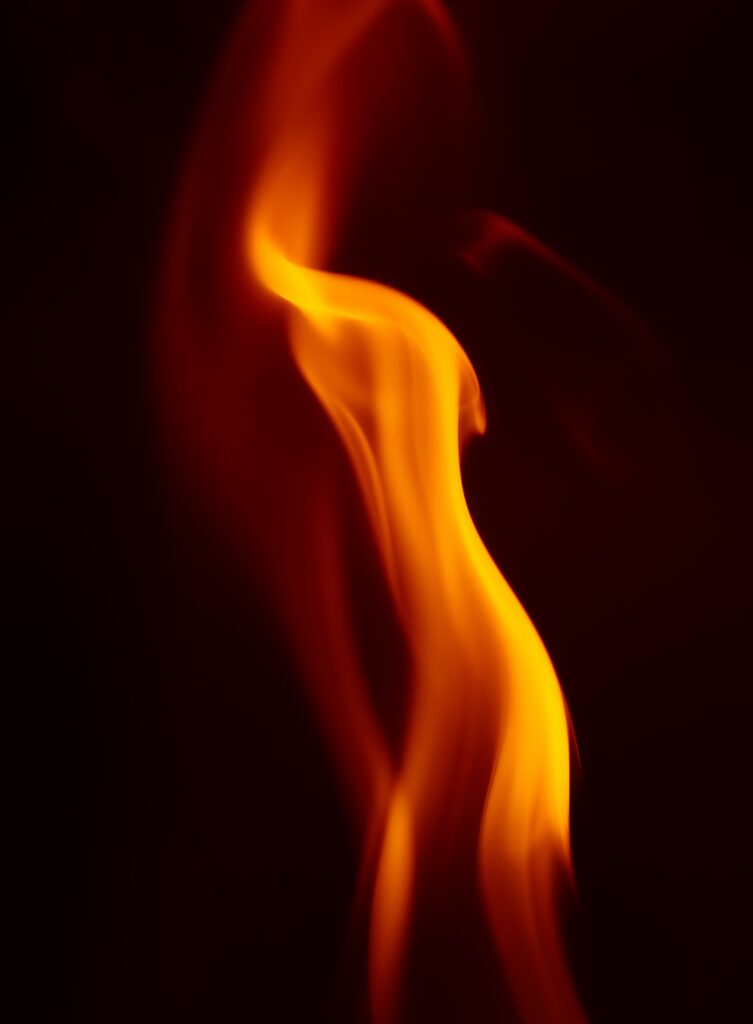

As Master Vagbhata has said: Almost all the diseases are caused due to mandagni means low digestive fire, especially the abdominal diseases.
Mandagni also denotes weaker metabolism.
Hypothyroidism is also related to low metabolism, in fact a cause of it. It is a resultant of Hypothyroidism. Treating weak digestive fire in hypothyroidism and kindling the same might catch the disease by its horns. This will also disable the continuation of pathogenesis and worsening the symptoms of the disease. Balanced digestive capacity also means proper digestion, conversion, distribution and utilization of food and nutrients. This also reflects proper conversion of food into energy, the channels of nutrition getting open and clear as an impact of digestive and tissue fires and eventual nourishment of the tissues.
Dosha predominance
| Symptoms of Hypothyroidism | Dosha predominance |
| Fatigue | Vata, Kapha |
| Weight gain | Kapha |
| Increased cold sensitivity | Kapha, Vata |
| Dry skin | Vata |
| Puffiness of the face | Kapha, Vata |
| Weakness in the muscles, muscle ache, tenderness, stiffness | Vata, Kapha |
| Pain, stiffness or swelling in the joints | Kapha, Vata |
| Constipation | Vata, Kapha |
| Hoarseness of the voice | Vata |
| Thinning of hairs | Vata |
| Slow heart rate | Kapha |
| Elevated blood cholesterol levels | Kapha |
| Enlarged thyroid glands (goiter) | Kapha, Vata |
| Irregular / heavy menstrual periods | Vata, Kapha |
| Depression | Kapha |
| Impaired memory | Kapha, Vata |
How ayurveda treatment hypothyroidism
The aggravated vata subtype which is enveloping the other vata subtype should be addressed first.
Vata and its subtypes causing obstruction is said to be associated with ama and have to be treated first.
The goal is to destroy ama including fasting, sudation, medicines, gruels and food light to digest with ama digesting herbs.
Following this, we have to strengthen the weak samana vata. This includes administration of medicines to kindle the digestive fire, emesis (procedure indicated for the expulsion of Kapha Dosha), light diet and use of Rasayanas formulations (herbs coumpounds ) to rejuvenate the tissus.
Ama dissolving medicines and foods should also be given.
Depending of Kapha doshas conditions, kapha alleviating herbs, diet, emesis and purgation therapies to expel excessive kapha can be administered.
Other strategies of treatment exists.
References
Mindfulness, Eating Behaviours, and Obesity: A Review and Reflection on Current Findings
The impact of yoga upon female patients suffering from hypothyroidism
Integrated Yoga and Naturopathy module in management of Metabolic Syndrome
